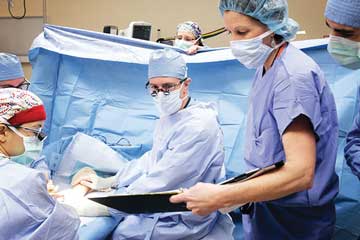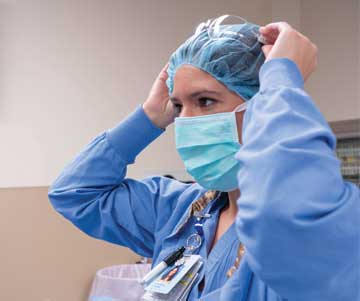These five strategies can help prevent these horrific and expensive mistakes.
 David Ring
David Ring
ABSOLUTE CERTAINTY Before incisions are made, all members of the perioperative team should feel empowered to express concerns about the location of the surgical site.
Wrong-site, wrong-side and wrong-patient surgeries are never acceptable, even on an OR's busiest day. Follow these five basic steps to avoid these devastating surgical errors.
Mark sites clearly. Verbal communication isn't enough. "It's very easy when you're doing the time out to say, ‘We're going to work on the second digit from the right,'" says James W. Bowers, BSN, RN, CNOR, TNCC, clinical nurse educator and service line coordinator for nine departments at West Virginia University Hospitals in Morgantown. "But if you turn the hand over, the second digit isn't the correct one you marked. It's the other second digit."
Confirm before cutting. Providers should reiterate where they will be working after the time out, just before the knife hits the skin. "Even though the surgeon has confirmed the site with the patient and the team confirmed the site during the time out, confusion can still occur once the patient is prepped and draped," says Dawn Yost, MSN, RN, CNOR, CSSM, business manager of perioperative services at West Virginia University Hospitals. Visual contact should be made with the site mark both during the time out and immediately before the initial incision. Make sure the mark isn't wiped off when the surgical site is prepped.
When in doubt, stop. If scrub personnel, the circulator or any nurse doesn't believe it's safe to proceed with a case, they should not hand the surgeon the knife. Any confusion about the surgical site is more than enough reason to call for a hard stop. New employees should be trained to be unafraid to speak up in these situations, and management should support them, even if an analysis shows the case would have been safe had it proceeded.
Enhance time outs. Hang a large poster in every OR that includes all information to be verified during time outs. The poster should serve as a reminder for nurses, anesthesia providers, surgeons and other staff to discuss all aspects of safe care. Use traditional patient identifiers such as birthdays and medical chart numbers in addition to confirming the patient's name. "We've had two patients with the same name having surgery at the same time," says Ms. Yost.
Check pre-op images. X-rays, CT scans and MRIs can assist in helping to ensure surgery is performed in the right place. "Things can get confusing once a patient is put onto their side or otherwise moved, so it's important to not only have all imaging available, but ensure that it is displayed so everyone can see it," says Mr. Bowers.
The goal, says Ms. Yost, is to create a culture of safety, perform consistent time outs and unrelentingly advocate for patients. "Then strenuously audit to make sure your daily practices really reflect what your policies are," she adds.
.svg?sfvrsn=be606e78_3)


.svg?sfvrsn=56b2f850_5)